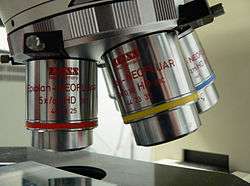Critical illumination
Critical illumination or Nelsonian illumination is a method of specimen illumination used for transmitted and reflected light (trans- and epi-illuminated) optical microscopy. Critical illumination focuses an image of a light source on to the specimen for bright illumination. Critical illumination generally has problems with evenness of illumination as an image of the illumination source (for example a halogen lamp filament) is visible in the resulting image. Köhler illumination has largely replaced critical illumination in modern scientific light microscopy although it requires additional optics which less expensive and simpler light microscopes may not have.
Optical principles

Critical illumination acts to form an image of the light source on the specimen to illuminate it. This image is formed by the condenser or collector lens. This illumination is bright but not always even, as any structure in the light source (for example the filament of a light bulb) will be visible in the resulting image. Homogenous light sources such as a flame or sunlight give more even illumination. Alternatively, a ground or opal glass diffuser can be used to homogenise the light source, but this will cause a significant amount of light to be scattered away from the sample.
